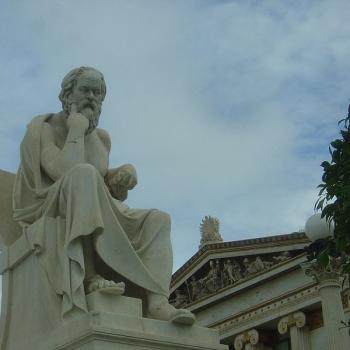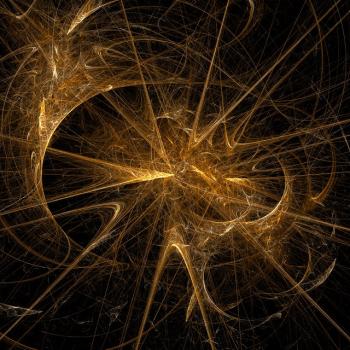
This occurred in a combox at the Debunking Christianity site, and is the altogether typical ill-informed attempted mockery from supposedly so intellectually superior atheists, who in their almost invariable / inevitable ignorance of biblical language and Christian thought end up making themselves look very silly indeed. Words of Robert Conner are in blue; those of Steampunk Gentleman in green; and those of Jim in brown.
*****
Interesting and well done. Here’s a conundrum from Matthew: ” the star they had seen when it rose went ahead of them until it stopped over the place where the child was…On coming to the house…” (Matt. 2: 9, 11, NIV)
The star stopped over the “place where the child was” which happened to be a “house,” not a manger.
No one’s saying it was a manger at this time. That’s the Christmas story of the shepherds in Luke. Almost all Christians believe that the Magi visited a Jesus who was one or two years old, not a newborn. So there was a house by then and not a temporary manger, which was a trough for animals to eat from (in a cave: which I visited in 2014: it’s definitely a cave). If Robert knew much of anything regarding Christian beliefs in the first place, he would already know this and I wouldn’t have to spend time explaining the elementary.
The text doesn’t say it rested over the “house” or “manger”; it says “the place where the child was”: which could mean the entire area of Bethlehem, just as we say “the moon was shining down at us” at a harvest dance, etc. Such celestial light being exactly on a manger (wrong) or specifically aimed at the holy family (which the text never says) is much more derived from Christmas cards and manger scenes than the Bible.
So…if you were standing on the surface of a planet, how would you know a star had stopped, much less stopped over a particular place the size of a house?
Since the text doesn’t claim that, this is a non sequitur and therefore not a thing that Christians need to explain or defend. They would simply have to ask the locals about this child who generated so much excitement one or two years previously, and where He lived. Word about notable events travels fast in small towns. They were led not just by a bright star, to go to Bethlehem, but also by biblical prophecy.
It would be like when I visited Woodstock, New York in 1992 and asked someone at a gas station if they knew where “Big Pink” was: the famous house where Bob Dylan and The Band (some of whom lived there) recorded The Basement Tapes. It so happened that this guy lived there, so he took me right to it.
If the star was going to stop over the house anyway, why did the magi go to Herod?
Obviously because he “summoned” them (Mt 2:7). One generally does what a king asks them to do.
If they found out where the Messiah would be born from a prophecy in the Old Testament, why did they need a guiding star?
They didn’t. It was “supplemental” evidence. They didn’t necessarily know about Bethlehem in particular until they arrived in Jerusalem. But a bright star had led them west to the area.
How did the star indicate which house Joseph and Mary lived in? Did the star twinkle in Morse code? (No, not that one! The one next door with the donkey in the driveway.) Did it drop star dust on the house? Did it beam extraterrestrial messages to the three magi’s tinfoil turbans? How did the magi know which house? The one with the Christmas tree and reindeer on the lawn?
It’s all delightful fun and games (ha ha), but completely irrelevant. The only person who is made a fool of by such silly and ridiculous questions is Robert himself.
***
How did they see it in the daylight?
Right, right. Go and get all technical on us!
Did the biblical text say they saw it in the daylight? But even if it did, have you never seen the moon in daylight? I easily saw the recent conjunction in fairly light twilight.
1st, I was joking about an event that never happened;
Of course, but obviously, Robert’s comment and atheist polemics in general are seeking to make the Bible and Christian belief look ridiculous: as if it is immediately impossible for any rational, scientific person to believe. Accordingly, your comment implied that it was ridiculous for a star to be seen in the daylight and also noting that the biblical text (in my recollection) doesn’t say they were guided by it in the daylight. In other words, implying that it did is a straw man in the first place.
2nd, travel at night or in the gloaming didn’t happen in ancient times;
That’s no problem, since all the biblical text requires is a star in the direction of Jerusalem at night, from Persia or Babylon to the east (the two likely places for the magi: more likely Persia because they were a priestly caste there). It doesn’t follow that they had to travel at night; only that they saw the star at night and noted what direction it was. So, noting that no travel at night happened (at least for any great distance) is a non sequitur.
3rd, daylight is immensely more obscuring of faint events than even twilight, the sun having an apparent magnitude of -26.74;
No one disputes that. Your burden is to establish that the Bible claimed that they followed it in daytime in the first place. I don’t see that they did, in the relevant passage (Matthew 2:1-12). But to go from Jerusalem to Bethlehem at night is only a six-mile journey, and this is the text that says the star “went before them”: which simply means that it was ahead of them as they traveled: just like we can say we “followed the sun west” and so forth.
4th, it appears fairly certain that the accounts of the nativity were added to the Gospel named “Luke” sometime round the beginning of the 2nd Century BCE & therefore the entire account is a fiction plagiarised from the myths of other faiths
And how does one prove such a thing, let alone it being supposedly “fairly certain”? Most such arguments form so-called “higher criticism” or atheist relentless skepticism are logically circular and rest on no indubitable evidence.
The star stopped over the “place where the child was” … How did the star indicate which house Joseph and Mary lived in?
That’s easy. There were surrounding hills with scorched imprints on the ground of shepherds and sheep along with fused metals here and there.Then in the valley, there was a patch of carbon deposits where the village once was and scorched outlines of houses on the ground. At ground zero of this incinerated desolation, there was an in tact manger with a giggling baby Jesus in it.
So you see, stellar proximity doesn’t have to be at odds with miraculous birth narratives.
Except that the text about the wise men is not about the newborn Jesus. I hate to break the news to you . . .
Irrelevant, a star cannot stop over a village, area, region or even continent. Learn basic astronomy.
This myth made sense only to those who believed the long debunked idea that stars were wandering objects that possessed free will existing on a heavenly surface.
Learn what it means to use phenomenological language, which the Bible habitually does, and as we all use all the time (“the sun went down”; “the sun was shining on my head so much that I got a terrible sunburn”; “I saw the sun shining right on the beautiful mountain in the distance.”). You make a fool of yourself, too, because you can’t manage to learn simple things about biblical language.
But it’s all very typical of atheists arguments against Christianity. You are what you eat. If you surround yourself with such silly arguments, you’ll end up parroting them and never learning anything.
I deal with many of these questions here: Star of Bethlehem, Astronomy, Wise Men, & Josephus.
Reading your article I see that it contains zero actual evidence that these specific events occurred. You cite historical facts unrelated to the nativity narrative in exactly the same manner as Bernard Cornwell cited historical realities unrelated to his narrative about his hero Richard Sharpe. Sharpe was a fiction.
In other words, even in your lede, you are deliberately and maliciously lying. You seek to deceive and fraudulently pretend to knowledge that you do not have.
Right-o! What a surprise that this is how the atheist who has little idea what he’s talking about, reacts.
[after this it was a “feeding frenzy” against me in the combox. I merely reproduce some of the “highlights”. The whole thing can be read at the link I provide at the top. Once the rank personal insults start, any further rational and constructive discussion is impossible]
“Atheist polemics …” Jokes are not polemics. Others read the comment as a joke, but you, twisted by hubris, think that it is polemical against your ridiculous version of Christianity. . . .
You cannot just assume the bible is accurate given that it contains so much that is fraudulent. . . .
Frankly your entire method is to assume that you and a pitiable cabal of biblical literalists are right and that every other person is wrong. . . .
I read your article and, unlike yourself, am aware that a lie is a lie even if the person who issues it believes it. . . .
I understand from other respondents that you pretend to Roman Catholicism . . .
Since we’re breaking news here, Dave, let me float a couple of ideas that may be news to you: [1] just because you believe something doesn’t make it true, [2] since you’re the one making the positive assertions, the burden to prove them is on you, and last but by no means least, [3] some folks, perhaps many folks, are smarter than you are, better read, and know more as well. I know that last one’s a real Christian buzz kill. . . .
Literate people of the current age are no more impressed by magical stars than they are by virgin births or any of the rest of the jabberwocky concocted to impress scientifically illiterate people living two millennia ago.
***
Photo credit: OpenClipart-Vectors (10-8-13) [Pixabay / Pixabay License]
***













